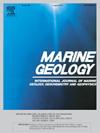Mechanisms and seasonal variability of sediment transport in a small tropical mountainous estuary-coastal system: Insights from the Selangor River, Malaysia
IF 2.2
3区 地球科学
Q2 GEOSCIENCES, MULTIDISCIPLINARY
引用次数: 0
Abstract
Small- and medium-sized mountainous rivers (SMRs) are critical pathways for delivering terrestrial sediment to coastal systems, particularly in the tropical regions where their dynamics are highly sensitive to anthropogenic influences. This study investigates the sediment transport processes and ultimate deposition patterns in the Selangor River estuary, Malaysia - a representative tropical macrotidal estuary characterized by complex nearshore topography and weak Coriolis effects. By combining field measurements (2023–2024) with sediment analysis, this research reveals three key findings. First, approximately 73.5 % of the annual sediment discharge (19.75 × 104 t) accumulates in estuarine tidal flats, with the northern tidal flats receiving twice the deposition of the southern tidal flats. Second, distinct seasonal transport regimes were evident: (i) during the dry season wave-driven sediment resuspension and tidal forces result in northwestward-southeastward transport, (ii) during the wet season stratified flows lead to significant sediment-freshwater decoupling, where river plumes disperse offshore while terrestrial sediments remain trapped near the estuary. Third, the unique sediment trapping mechanism, different from both large river systems and wave-dominated tropical SMRs, resulting from the interaction of strong tidal currents, seasonal river discharge, and offshore water intrusion form the Strait of Malacca. These findings provide a new conceptual framework for understanding sediment retention in tropical macrotidal estuaries, with implications for coastal management under climate change and intensifying anthropogenic pressures.

一个小型热带山区河口-海岸系统中沉积物运输的机制和季节变化:来自马来西亚雪兰莪河的见解
中小型山地河流是向沿海系统输送陆地沉积物的重要途径,特别是在其动态对人为影响高度敏感的热带地区。本文研究了马来西亚雪兰莪河河口的泥沙输运过程和最终沉积模式。雪兰莪河河口是一个具有代表性的热带大潮河口,近岸地形复杂,科里奥利效应弱。通过将现场测量(2023-2024年)与沉积物分析相结合,本研究揭示了三个关键发现。首先,年输沙量的73.5% (19.75 × 104 t)聚集在河口潮滩,其中北部潮滩的输沙量是南部潮滩的两倍。其次,明显的季节输送机制:(1)在旱季,波浪驱动的沉积物再悬浮和潮汐力导致西北-东南输送;(2)在雨季,分层流动导致沉积物-淡水明显脱钩,河流羽流分散到近海,而陆地沉积物仍被困在河口附近。第三,马六甲海峡强潮流、季节性河流流量和近海水入侵共同作用,形成了独特的泥沙捕获机制,不同于大型河流水系和以波浪为主导的热带小流域。这些发现为理解热带大潮河口沉积物滞留提供了一个新的概念框架,对气候变化和人为压力加剧下的海岸管理具有重要意义。
本文章由计算机程序翻译,如有差异,请以英文原文为准。
求助全文
约1分钟内获得全文
求助全文
来源期刊

Marine Geology
地学-地球科学综合
CiteScore
6.10
自引率
6.90%
发文量
175
审稿时长
21.9 weeks
期刊介绍:
Marine Geology is the premier international journal on marine geological processes in the broadest sense. We seek papers that are comprehensive, interdisciplinary and synthetic that will be lasting contributions to the field. Although most papers are based on regional studies, they must demonstrate new findings of international significance. We accept papers on subjects as diverse as seafloor hydrothermal systems, beach dynamics, early diagenesis, microbiological studies in sediments, palaeoclimate studies and geophysical studies of the seabed. We encourage papers that address emerging new fields, for example the influence of anthropogenic processes on coastal/marine geology and coastal/marine geoarchaeology. We insist that the papers are concerned with the marine realm and that they deal with geology: with rocks, sediments, and physical and chemical processes affecting them. Papers should address scientific hypotheses: highly descriptive data compilations or papers that deal only with marine management and risk assessment should be submitted to other journals. Papers on laboratory or modelling studies must demonstrate direct relevance to marine processes or deposits. The primary criteria for acceptance of papers is that the science is of high quality, novel, significant, and of broad international interest.
 求助内容:
求助内容: 应助结果提醒方式:
应助结果提醒方式:


